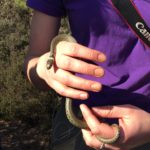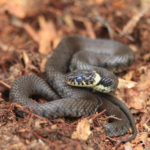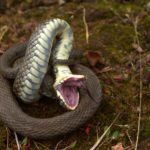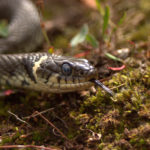Grass Snake

Back Adder Grass Snake Smooth Snake Common Lizard Sand Lizard Slow Worm
GRASS SNAKE
Natrix helvetica
Our largest native snake, these water specialists can occasionally reach around 2m in length. Easily identified by a black and yellow collar around the neck, grass snakes range from grey to light brown to olive green. Some individuals can be marked with tiger stripes and some very rare colour morphs have been found with light zig-zags on the back. Grass Snakes are fantastic swimmers and can even be found navigating fast flowing rapids, or gobbling goldfish in garden ponds!
- Grass snake handled by Amphibian & Reptile Conservation (ARC)
- Grass snake © Rob Solomon
- Grass snake displaying thanatosis © Jamie Neaves
- Grass snake © Jamie Neaves
[Click on the thumbnails to open]
Where/when to find them
These snakes tend to be associated with water, but can be found in a variety of habitats including more urban environments such as gardens and canals if there is enough prey and undisturbed areas of vegetation. Rivers, wetlands, wet heath and marshes are also good areas. Like other snakes in the UK they hibernate, and can be found active from early spring to mid autumn.
Adaptations
Grass Snakes have evolved two excellent defence mechanisms. If disturbed they release a foul smelling liquid, enough to put predators off their dinner. They also death feign, lying their bodies and heads on their side or upside down, oozing a smell of decay.
Diet
Carnivores. An amphibian and fish specialist, these snakes hunt frogs, toads, newts, fish and the occasional water bird chick.
Rarity
Our most common snake, but numbers have seen sharp drops over the years due to habitat loss and disturbance. Urbanisation is a big problem, as well as developments and roads blocking populations from joining up. They are protected from killing or harm by law.
Read more
On our blog: Introducing the Pond Raider!
#MoreThanJustNightjars





